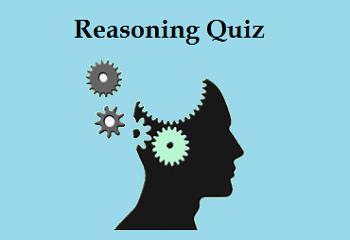Hello Aspirants. Welcome to Online Reasoning Section in AffairsCloud.com. Here we are creating sample questions which is common for all the IBPS,SBI exam and other competitive exams. We have included Some questions that are repeatedly asked in bank exams !!!
Directions (1-5): Study the following information to answer the given questions:
In a certain code language ‘cold weather in delhi’ is written as ‘ pa sa ma ze’ , ‘cold wave in north india’ is written as ‘ pa ja ma ta ne’ , ‘enjoy the india weather’ is written as ‘ sa za ja ro’ and ‘ in the season’ is written as ‘ ga za ma’.
1. What is the code for ‘enjoy’ ?
1) ta
2) ka
3) ja
4) ro
5) ga
2. What does ‘ze’ stand for?
1) season
2) delhi
3) the
4) india
5) north
3. Which of the following may be the code for ‘enjoy the happy season’?
(1) ro ga ze ja
(2) ro za ma ja
(3) ja ro ga sa
(4) ra za ga pe
(5)none of these
4. What is the code for ‘india’ ?
(l) ja
(2 )ta
(3) ne
(4) ga
(5) ze
5. Which of the following represents ‘ cold wave in delhi’ ?
(1) pa ta sa ga
(2) ja sa pa ra
(3)pa ke ma ze
(4) sa pa ma ze
(5)can’t be determined
Directions (6-10): Study the following information carefully and answer the given questions:
Twelve people are sitting in two parallel rows containing six people each, in such a way that there is an equal distance between adjacent persons. In row – 1, P, Q, R, S, T and V are seated and all of them are facing south. In row – 2, A, B, C, D, E and F are seated and all of them are facing north. Therefore, in the given seating arrangement each member seated in a row faces another member of the other row.
A sits third to right of D. Neither A nor D sits at extreme ends. T faces D. V does not face A and V does not sit at any of the extreme ends. V is not an immediate neighbor of T. B sits at one of the extreme ends. Only two people sit between B and E. E does not face V. two persons sit between Rand Q. R is not an immediate neighbor of T. C does not face V. P is not an immediate neighbor of R.
6. Who amongst the following sit at extreme ends of the rows?
(1) B, E (2) S, T
(3) P, R (4) B, F
(5) None of these
7. Who amongst the following faces A?
(1) R (2) P
(3) P (4) Q
(5) S
8. How many persons are seated between T and S?
(1) One (2) Two
(3) Three (4) Four
(5) None
9. P is related to V in the same way as C is related to F. to which of the following is E related to, following the same pattern?
(1) B (2) D
(3) C (4) A
(5) None of these
10. Which of the following is true regarding F?
(1) F sits fourth to right of C
(2) F is not an immediate neighbor of A.
(3) F sits third to left of D
(4) F sits at one of the extreme ends of the line
(5) F faces V.
Directions (11-15):In the following questions, the symbols @, ©, #, $ and % are used with the meaning as indicated below.
P©V means ‘P is either greater than or equal to V’.
P%V means ‘P is either smaller than or equal to V’.
P@V means ‘P is neither greater than nor smaller than v’.
P#V means ‘P is smaller than v’.
P$V means ‘P is greater than v’.
Now in each of the following questions, assuming the given statements to be true, find which of the four Conclusions I, II, III andf IV given below them is/are definitely true, give your answer accordingly.
A. If only conclusion I is true.
B. If only conclusion II is true.
C. If either conclusion I or II is true.
D. If neither conclusion I nor II is true.
E. If both conclusion I and II are true.
11. Statements D$N, N#A, A©S
Conclusions I. S#N II.D$A
12. Statements K©T, T$R, R#S
Conclusions I. S$T II.R#K
13. Statements J$U, U©M, M#P
Conclusions I. J$M II.P$U
14. Statements F#A, A@T, T$H
Conclusions I. F#H II.F©H
15. Statements M%I, I#T, T@H
Conclusions I. H$I II.T$I
Directions (16-18): Study the following information to answer the given questions:
A building has seven floors numbered one to seven, in such a way that the ground floor is numbered one, the floor above it, numbered two and so on such that the topmost floor is numbered seven. One out of seven people viz. A, B, C, D, E, F and G lives on each floor. A lives on fourth floor. E lives on the floor immediately below F’s floor. F does not live on the second or the seventh floor.
C does not live on an odd numbered floor. B does not live on a floor immediately above or below C’s floor. D does not live on the topmost floor. G does not live on any floor below E’s floor.
16. Who lives on the topmost floor?
(1) B (2) C
(3) E (4) G
(5) Cannot be determined
17.Who lives immediately above D’s floor?
(1) A (2) B
(3) C (4) F
(5) G
18. Four of the following are alike in a certain way and so form a group. Which is the one that does not belong to that group?
(1) F (2) D
(3) B (4) G
(5) C
19. Farah starts from Point A and walks 20 m towards North. He then takes a left turn and walks 30 m before taking a right turn and walking 10 m. He finally takes a left turn, walks 30 m and stops at Point B. After Farah reaches the final Point B, Abhay starts from Point A. He walks 5 m towards the East, takes a left turn and walks 30 m to reach Point C. How far and towards which direction would Farah have to walk in order to meet Abhay at Point C?
(1) 90 m towards West
(2) 55 m towards North
(3) 65 m towards East
(4) 90 m towards South
(5) 35 m towards West
————-********—————
Answers:
1. 4
2. 2
3. 4
4. 1
5. 5
Solutions (6-10)
6. 3
7. 5
8. 2
9. 1
10.5

Solutions (11-15)
11. 4
12. 2
13. 1
14. 4
15. 5
Solutions (16-18)
7th – G
6th – C
5th – D
4th – A
3rd – F
2nd – E
1st – B
16. 4
17. 3
18. 5
19. 3





